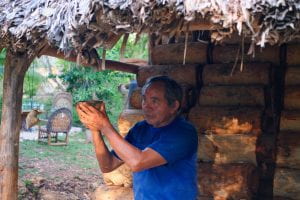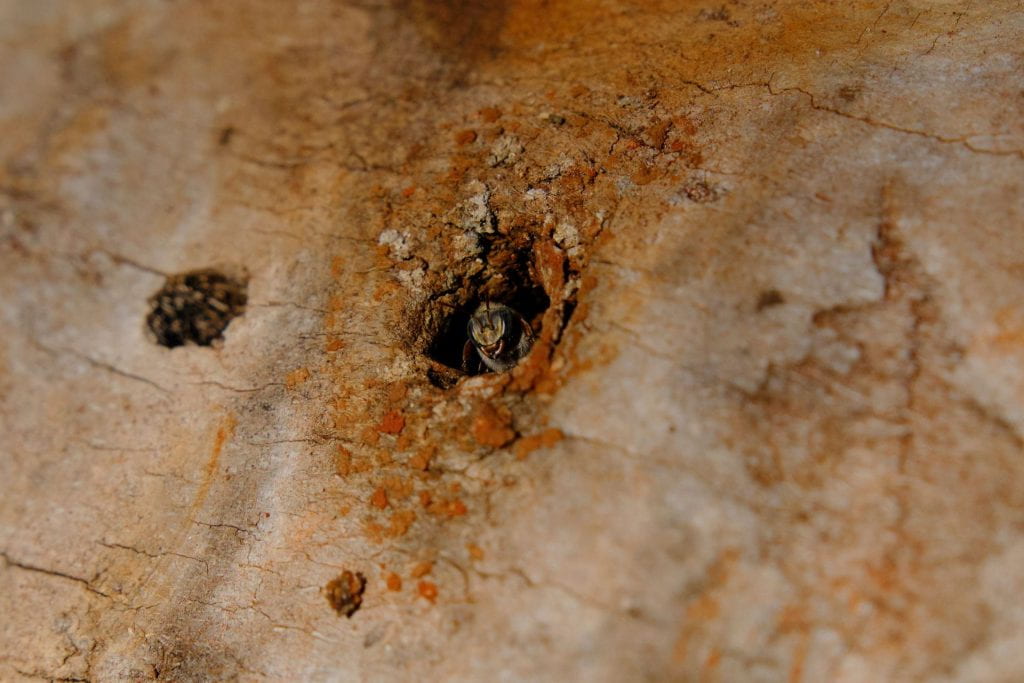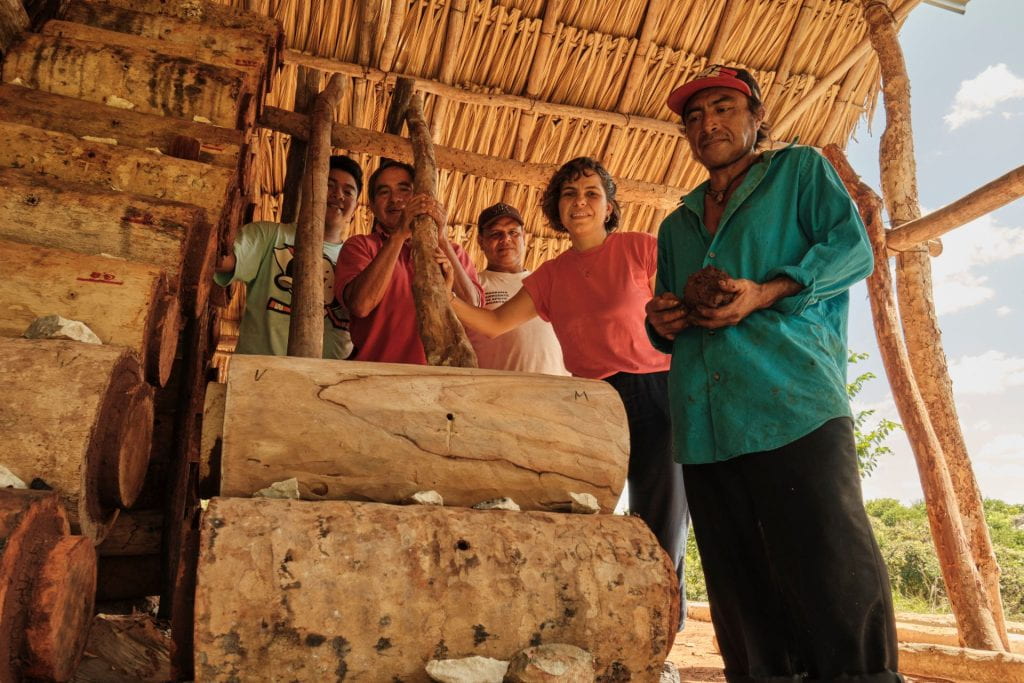A Journey to the Universe of Bees
From the Archives to the Fields
Beekeepers in the Yucatán Peninsula have historically interacted with two species of bees for extracting honey and beeswax. The first species, Melipona beecheii, is native to the Yucatán Peninsula—currently the states of Campeche, Quintana Roo and Yucatán in southeast México—, and can only live in the tropical environments of Central America and the Caribbean. The second, Apis mellifera, is native to Europe but slowly spread throughout the Americas in the context of the Columbian exchange that occurred after 1492, and now populates almost every corner of the Earth.
My dissertation looks at the local knowledge, technologies, economies and environmental changes led by beekeepers in the Yucatán Peninsula from the late 18th century to the first-half of the 20th century. I follow the transregional and transnational circulation of apiculture instruments, honeybees, and apiculturists between the northern hemisphere—principally Western Europe and the United States—and the American tropics, particularly the three regions connected by the basin of the Gulf of México: Florida, Cuba and southeast México.
My historical journey began in the field when I interviewed and observed beekeepers in the Yucatán countryside between 2014 and 2016. I learned that the Yucatán Peninsula is the most prolific apiary in the country, producing 40% of the Mexican honey that is exported to the European Union. Apiculture has been practiced in the region for three generations.  The parents of today’s beekeepers taught their children—mostly male campesinos or farmers—the practice of apiculture, while they themselves had learned through government workshops and farming campaigns, as well as through brochures and commercial journals published in Spanish by a U.S. beekeeping brand which delivered its publications by mail to their homes, mostly located in rural towns. This brand, the A.I. Root Co., also sold tools, instruments and all the supplies required for starting out in the business of apiculture.
The parents of today’s beekeepers taught their children—mostly male campesinos or farmers—the practice of apiculture, while they themselves had learned through government workshops and farming campaigns, as well as through brochures and commercial journals published in Spanish by a U.S. beekeeping brand which delivered its publications by mail to their homes, mostly located in rural towns. This brand, the A.I. Root Co., also sold tools, instruments and all the supplies required for starting out in the business of apiculture.
México is currently the world’s sixth biggest producer and third largest exporter of honey. Thus, at the beginning of my research, I wondered why this place came to be so important for honey production. My expectations promptly changed, however, when I began my conversations with beekeepers and learned two important facts that would come to define the course of my research and dissertation.
The first of these is that the beekeepers from the Yucatán Peninsula have a solid bond with their past. When explaining the origins of their prosperity in terms of apiculture, they deploy a narrative that goes back to their “Maya ancestors” who were the “best beekeepers of Mesoamerica,” before Spanish colonization. The bee that has been domesticated by Yucatec Maya for over 2,500 years is Melipona beecheii, a stingless bee native to the region. I became intrigued by these bees that I did not know about before I began to be interested in honey and bees. I was amazed by the fact that some other bees, different from the ones we are familiar with, also produce honey and do not sting. Beekeepers told me that these bees are endangered, and that their population had decreased since the Spanish conquest, when Europeans brought their own hives of Apis mellifera.

Melipona beecheii is called in Maya Xunáan Kaab.
This preliminary experience enabled me to transition from focusing on a commodity—honey—to focusing on the people, practices and bees, and places where honey has historically been produced under different types of environmental exploitation. The second observation to have a big impact on me was that the honeybee which produces the honey consumed on the global market is not native to Yucatán, nor even to the Americas. Apis mellifera is also called by beekeepers in Yucatán as “abeja americana,” or American honeybee because they know that the first honeybees were brought from the United States, during the 20th century. The connection between Maya beekeeping, the colonial period and the influence of the United States intrigued me but I couldn’t find any secondary sources with a compelling chronology and explanation of how and why—after three centuries of experimentation in the Americas—the honeybee came to be the most common bee on the continent, and what the consequences of its omnipresence are.
In the following years I visited archives in Cuba, Mexico and the United States. I also conducted fieldwork in apiaries, and I took courses on apiculture and meliponiculture (or beekeeping with stingless bees) with beekeepers who generously taught me their knowledge and methods for taking care of the hives. Beekeeping with Melipona beecheii and Apis mellifera is a completely different experience, but in the case of the Yucatán Peninsula, where the two forms of honey and wax extraction have coexisted since the 20th century, each has left its mark on the other. Beekeeping is meticulous work. It requires a trained eye to do inspections and to examine the pollen, brood, larvae and the amounts of honey that make up the hive. Each hive I have observed is a unique universe that can be only understood as an environmental entanglement of the labor force of the colony and the beekeeper’s thorough work.
In the archives, I learned that Melipona beecheii’s population did not decrease during the Spanish colonial period. In fact, Yucatec Maya communities continued to be the primary beekeepers under Spanish colonial rule from the 16th to the 18th century, supplying the whole Viceroyalty of New Spain with wax of wild stingless bees and honey of the Melipona beecheii. The Catholic church drove the demand and consumption of candles made from beeswax—used to illuminate church interiors and during sacred festivities. Beekeeping with Melipona remained an important activity in the 19th century, after Mexico gained its independence from the Spanish crown, and during the period of haciendas and henequen plantations. Although the demand for beeswax candles decreased, honey of Melipona continued to be locally consumed not only as a sweetener but as an essential ingredient in healing remedies.
One of the most revealing primary sources that I found in the General Archive of the State of Yucatán (Archivo General del Estado de Yucatán AGEY), in Mérida city, is the 1878 census that includes the counting of hives under the concept of “Domestic Animals.” It shows that there were almost 210,000 Melipona beehives distributed in pueblos, haciendas, ranchos and cities in Yucatán. These hives would produce 553,000 pounds of honey per year. This can be compared to the 1,469,318 pounds of honey extracted with the modern apiculture method recorded by the New York State Census of 1874, keeping in mind the fact that New York State was three times bigger than the state of Yucatán at that time. This occurred before apiculturists brought modern hives of Apis mellifera from the United States and introduced them in rural Yucatán in the 20th century.
While the Yucatan soil was a successful bee pasture for Melipona, up to the north, farmers and beekeepers designed and promoted a new method for honey and wax extraction that they called modern apiculture—the method used for extracting honey that prevails to this day around the world. This method is based on the exclusive use and breeding of the honeybee, or Apis mellifera. Large-scale hive management and innovative and standardized hive designs contributed to the notion of apiculture as a modern enterprise. The formation of modern apiculture was an active process that involved the creation of global networks putting in circulation bees, tools, knowledge, texts and markets.
Although the Apis mellifera had been expanding across the New World due to human-assisted migration since the beginning of colonization, the birth of modern apiculture allowed beekeepers to move the species from Europe to northern regions of the United States in the mid-19th century. Beekeepers then rapidly spread honeybees south, first to Florida, then to Cuba in the late 19th century and México in the early 20th century.
Apiculture in tropical locations has been considered as a success story in agriculture studies. For example, apiculturists in the 20th century realized that honeybee is more productive in tropical environments than in the northern regions. In this context, bee experts actively fought for the displacement of what was considered as backward practices in rural locations. However, I have found that in the 20th century, beekeepers, entomologists and apiculturists relocated honeybees to environments already rich in bee biodiversity, such as the Yucatán Peninsula. In this case, modern hives of Apis mellifera were incorporated by beekeepers in rural landscapes in the 1910s, with the support of the government that bought hives to the United States. Thus beekeepers—whether Indigenous, Yucatecans or mestizos—became active agents of environmental change by experimenting, innovating and breeding new species of honeybees using the modern method of apiculture. In 1930, Mexican beekeepers reported that there were 1.3 million hives in the country. Just to have an idea, currently, there are 2.7 million honeybee colonies in the United States, and 2.1 million in Mexico. By the end of the 1930s, apiculture was considered “the best rural business in Yucatán.” In less than two decades, the Apis mellifera populated the entire peninsula and became part of the environment and landscape of the region. This change had a strong impact in the agrarian society with the formation of the figure of the apiculturist—or apicultor—as an active identity that did not exist in the region before the 20th century.
Contemporary apiculturists in Yucatán generally keep their Apis mellifera apiaries far from their pueblos, homes and livestock, as stipulated in the regulations, to avoid any attacks on humans or domestic animals by the bees. However, some apiculturists also owned in their household Melipona beecheii hives. Although beekeeping is a predominantly male practice in Yucatán, in the last years there is an increasing number of women practicing meliponiculture—they call themselves meliponicultoras. Melipona hives are often located in backyards or patios, since this species presents no danger to the community. Unlike the honey from Apis mellifera, which is highly industrialized and subjected to pasteurization, the honey of Melipona beecheii is not subject to industrial processes, nor commercialized on the global market, and is instead consumed locally, where it is also an important component in healing practices. Despite these differences, beekeepers manifest a deep and intimate attachment to both Melipona beecheii and Apis mellifera, calling them abejitas in Spanish, or “little bees.”
Beekeepers in Campeche, Quintana Roo and Yucatán—some of whom identified themselves as Maya apiculturists or apicultores Mayas—had been receiving media attention since 2012. They became well known as environmental activists when they started a fight against Monsanto for their use of GMO (genetically modified organisms) on crops in southeastern México. The Mexican Ministry of Agriculture (SAGARPA) had issued a permit to Monsanto allowing commercial planting of Roundup Ready soybeans. Despite the protests, the government authorized Monsanto to plant more than 250,000 hectares (618,000 acres) in seven states. Beekeepers from the Yucatán Peninsula came together, organized and convinced the Supreme Court of Justice (SCJN) and the public that a coexistence between honey production and genetically modified soybeans was not possible.

Luis Armando Quintal Medina is known in the pueblo as “Padre Luis”. A photo with his team of beekeepers and me.
Experts and beekeepers attributed the use of glyphosate—the active ingredient of Roundup crops such as soybeans, alfalfa and cotton among others—as the origin of environmental damage to water, soil and honeybee colonies in the Yucatán Peninsula’s most fertile land. Unlike other types of domestic animals used in farming, bees cannot be fenced in or enclosed, so the crops and substances used in surrounding lands affect neighboring apiaries. This became a clear case of environmental justice and the rights of Indigenous peoples over their territory, because in accordance with the Mexican Constitution the government has an obligation to consult Indigenous communities before making major decisions in their territory, such as the use of GMO. In November 2015, the Supreme Court of México ruled unanimously that Indigenous communities must be consulted before the planting of GMO soy in the seven states.
The narrative deployed by the media proclaimed victory for Mexican and Maya beekeepers over the transnational Monsanto company. In fact, this case has resonated around the world, tying into the growing concern for the declining population of pollinators and playing its part in one of the most global conservation and environmental campaigns of the last two decades: Save the Bees. This campaign promotes the conservation of the honeybee, but while experts agree that Apis mellifera is crucial in commercial agriculture and the economy, only keeping honeybees is not wildlife conservation. Biologists, entomologists, and bee experts—several from the field of tropical apiculture—have shown that the universe of bees is more diverse than the omnipresent Apis mellifera, and that the ecosystem is more complex than an apiary.
In the specific case of Maya beekeepers against Monsanto, some scholars have questioned the romanticizing rhetoric deployed by the media, government and organizations, and have pointed out that multiple actors, institutions, governments, experts, activists and a legal apparatus are involved in this process. In the same vein, my research has found that the monoculture regime that contemporary actors and activists—such as beekeepers—are against is rooted in the same projects that boosted the exclusive use of modern apiculture, not only in the Yucatán Peninsula, but across the entire world since the early 20th century. These types of contradictions open the door for looking closely at what I call innovation-as-resistance in agricultural practices, or the decolonial condition to locally—and autonomously—shape environments as a response to state-guided national development projects. In a country such as Mexico, recently named the deadliest country for environmental activists, the question is deeper, and it requires a critical approach to the history of agrarian identities in the context of ecological change. It helps us to understand how Apis mellifera, a honeybee new to the region—and that somehow pushed aside a native bee and Indigenous practices—became the tool for facing monoculture technologies, land tenure rights, environmental change and the use of agrochemicals in the 21st-century agrarian context.
Angélica Márquez-Osuna is a Ph.D. candidate in the History of Science department at Harvard. Angélica studies the history of Latin America, specializing in environment, circulation of knowledge, agriculture and farming practices.
Credits for all photos: Pablo Sepúveda-Díaz
These are photos of a traditional meliponary U Naajil Yuum K’iin in Maní, Yucatán.
Related Articles
Editor’s Letter – Animals
Editor's LetterANIMALS! From the rainforests of Brazil to the crowded streets of Mexico City, animals are integral to life in Latin America and the Caribbean. During the height of the Covid-19 pandemic lockdowns, people throughout the region turned to pets for...
Where the Wild Things Aren’t Species Loss and Capitalisms in Latin America Since 1800
Five mass extinction events and several smaller crises have taken place throughout the 600 million years that complex life has existed on earth.
A Review of Memory Art in the Contemporary World: Confronting Violence in the Global South by Andreas Huyssen
I live in a country where the past is part of the present. Not only because films such as “Argentina 1985,” now nominated for an Oscar for best foreign film, recall the trial of the military juntas…



